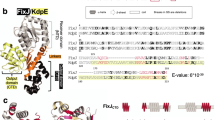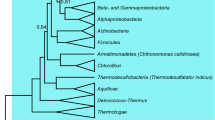Abstract
STUDIES of extant protein sequences indicate that amino-acid insertions and deletions are preferentially located in loop regions1, which has traditionally been explained as the result of selection removing deleterious mutations within secondary structural elements from the population. But there is no a priori reason to discount the possibility that insertions within secondary structure could either be tolerated until compensatory mutations arise, or have effects that are propagated away from secondary structure into loops. Earlier studies have indicated that insertions are generally tolerated, although much less well within secondary structure elements than in loop regions2–8. Here we show that amino-acid insertions in an α-helix of T4 lysozyme can be accepted in two different ways. In some cases the inserted amino acids are accommodated within the helix, leading to the translocation of wild-type residues from the helix to the preceding loop. In other cases the insertion causes a ‘looping-out’ in the first or last turn of the helix. The individual structural responses seem to be dominated by the maintenance of the interface between the helix and the rest of the protein.
This is a preview of subscription content, access via your institution
Access options
Subscribe to this journal
Receive 51 print issues and online access
$199.00 per year
only $3.90 per issue
Buy this article
- Purchase on Springer Link
- Instant access to full article PDF
Prices may be subject to local taxes which are calculated during checkout
Similar content being viewed by others
References
Pascarella, S. & Argos, P. J. molec. Biol. 224, 461–471 (1992).
Barany, F. Proc. natn. Acad. Sci. U.S.A. 82, 4202–4206 (1985).
Sondek, J. & Shortle, O. Proteins: Struct. Funct. Genet. 7, 299–305 (1990).
Sondek, J. & Shortle, D. Proteins: Struct. Funct. Genet. 13, 132–140 (1992).
Freimuth, P. I., Taylor, J. W. & Kaiser, E. T. J. biol. Chem. 265, 896–901 (1990).
Marti, T., Otto, H., Rösselet, S. J., Heyn, M. P. & Khorana, H. G. Proc. natn. Acad. Sci. U.S.A. 89, 1219–1223 (1992).
Starzyk, R. M., Burbaum, J. J. & Schimmel, P. Biochemistry 28, 8479–8484 (1989).
Ladant, D., Glaser, P. & Ullmann, A. J. biol. Chem. 267, 2244–2250 (1992).
Heinz, D. W., Baase, W. A. & Matthews, B. W. Proc. natn. Acad. Sci. U.S.A. 89, 3751–3755 (1992).
Eriksson, A. E. et al. Science 255, 178–183 (1992).
Gray, T. M. & Matthews, B. W. J. molec. Biol. 175, 75–81 (1984).
Milner-White, E. J. & Poet, R. Trends biochem. Sci. 12, 189–192 (1987).
McIntosh, L. P., Wand, A. J., Lowry, D. F., Redfield, A. G. & Dahlquist, F. W. Biochemistry 29, 6341–6362 (1990).
Lee, B. & Richards, F. M. J. molec. Biol. 55, 379–400 (1971).
Connolly, M. Science 221, 709–713 (1983).
Lesk, A. M. & Chothia, C. J. molec. Biol. 136, 225–270 (1980).
Presta, L. G. & Rose, G. D. Science 240, 1632–1641 (1988).
Bashford, D., Chothia, C. & Lesk, A. M. J. molec. Biol. 196, 199–216 (1987).
Dao-pin, S., Baase, W. A. & Matthews, B.W. Proteins: Struct Funct Genet. 7, 198–204 (1990).
Zhang, X.-J., Baase, W. A. & Matthews, B. W. Biochemistry 30, 2012–2017 (1991).
Becktel, W. J. & Schellman, J. A. Biopolymers 26, 1859–1877 (1987).
Matsumura, M. & Matthews, B. W. Science 243, 792–794 (1989).
Kunkel, T. A., Roberts, J. D. & Zakour, R. A. Meth. Enzym. 154, 367–382 (1987).
Poteete, A. R., Dao-pin, S., Nicholson, H. & Matthews, B. W. Biochemistry 30, 1425–1432 (1991).
Streisinger, G., Mukai, F., Dreyer, W. J., Miller, B. & Horiuchi, S. Cold Spring Harb. Symp. quant. Biol. XXVI, 25–30 (1961).
Weaver, L. H. & Matthews, B. W. J. molec. Biol. 193, 189–199 (1987).
Jancarik, J. & Kim, S.-H. J. appl. Crystallogr. 24, 409–411 (1991).
Alber, T., Dao-pin, S., Nye, J. A., Muchmore, D. C. & Matthews, B. W. Biochemistry 26, 3754–3758 (1987).
Author information
Authors and Affiliations
Rights and permissions
About this article
Cite this article
Heinz, D., Baase, W., Dahlquist, F. et al. How amino-acid insertions are allowed in an α-helix of T4 lysozyme. Nature 361, 561–564 (1993). https://doi.org/10.1038/361561a0
Received:
Accepted:
Issue Date:
DOI: https://doi.org/10.1038/361561a0
This article is cited by
-
Vitamin D and lumisterol derivatives can act on liver X receptors (LXRs)
Scientific Reports (2021)
-
Accessing unexplored regions of sequence space in directed enzyme evolution via insertion/deletion mutagenesis
Nature Communications (2020)
-
Tubulinopathies continued: refining the phenotypic spectrum associated with variants in TUBG1
European Journal of Human Genetics (2018)
-
Insertion of antihypertensive peptides in acidic subunit from amaranth 11S induces contrasting effects in stability
Applied Microbiology and Biotechnology (2018)
-
Computationally Design of Inhibitory Peptides Against Wnt Signaling Pathway: In Silico Insight on Complex of DKK1 and LRP6
International Journal of Peptide Research and Therapeutics (2018)
Comments
By submitting a comment you agree to abide by our Terms and Community Guidelines. If you find something abusive or that does not comply with our terms or guidelines please flag it as inappropriate.



